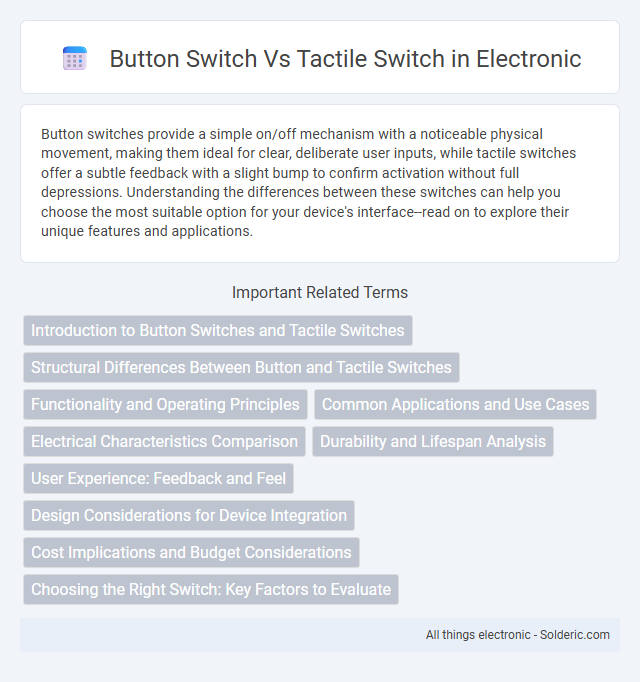Button switches provide a simple on/off mechanism with a noticeable physical movement, making them ideal for clear, deliberate user inputs, while tactile switches offer a subtle feedback with a slight bump to confirm activation without full depressions. Understanding the differences between these switches can help you choose the most suitable option for your device's interface--read on to explore their unique features and applications.
Comparison Table
| Feature | Button Switch | Tactile Switch |
|---|---|---|
| Function | Controls electrical circuit by pressing a button | Provides tactile feedback with a click on press |
| Design | Larger, often raised or flat | Small, compact, with a distinct tactile bump |
| Applications | Keypads, remote controls, appliances | Electronics, keyboards, consumer devices |
| Durability | Moderate, depends on quality | High, supports millions of presses |
| Feedback | May lack tactile feedback | Provides clear physical response |
| Cost | Generally lower | Moderate to slightly higher |
Introduction to Button Switches and Tactile Switches
Button switches, commonly used in electronic devices, are mechanical components that complete or disrupt a circuit when pressed, providing visual or physical feedback. Tactile switches, a subset of button switches, feature a small, dome-shaped actuator that offers a distinct tactile bump, ensuring precise user input and reliable performance in compact spaces. Both switch types play crucial roles in user interfaces, with tactile switches favored for applications requiring low-profile, responsive control.
Structural Differences Between Button and Tactile Switches
Button switches feature a larger, often protruding actuator that requires more force and travel distance to engage, while tactile switches have a smaller, low-profile design with a distinct feedback point created by a tactile bump. The internal mechanism of button switches typically involves a plunger that completes the circuit upon pressing, whereas tactile switches use a dome or membrane that provides a noticeable "click" sensation without visible movement. Understanding these structural differences helps you select the appropriate switch type for your desired tactile response and device design constraints.
Functionality and Operating Principles
Button switches operate by completing or breaking an electrical circuit when pressed, using a mechanical mechanism that allows full travel and toggling between on and off states. Tactile switches provide a momentary contact with a noticeable physical feedback, such as a click or bump, designed for quick and precise inputs in electronic devices. Your choice depends on whether you need a maintained connection or a brief, responsive activation.
Common Applications and Use Cases
Button switches are widely used in home appliances, consumer electronics, and industrial control panels due to their durability and easy operation for on/off functions. Tactile switches are common in keyboards, remote controls, and small handheld devices where precise, momentary input with tactile feedback enhances user experience. Your choice depends on whether you need a robust switch for repeated on/off control or a responsive switch for quick, tactile interactions.
Electrical Characteristics Comparison
Button switches typically offer a higher current rating, often capable of handling up to 3A at 250V AC, making them suitable for power applications, while tactile switches usually support lower currents around 50mA at 12V DC, ideal for signal-level circuits. The contact resistance in tactile switches is generally lower, around 100 milliohms, providing consistent feedback, whereas button switches may exhibit higher contact resistance due to their mechanical design. Voltage ratings also differ, with button switches designed for higher voltage applications and tactile switches optimized for low-voltage digital interfaces.
Durability and Lifespan Analysis
Button switches typically offer higher durability with mechanical parts designed for up to 1 million actuations, making them suitable for heavy-duty applications. Tactile switches, while providing precise feedback and shorter travel distances, usually have a lifespan ranging from 100,000 to 500,000 cycles, ideal for control panels and consumer electronics. The choice depends on usage frequency, with button switches favored in environments requiring robust longevity and tactile switches preferred for moderate use with reliable tactile feedback.
User Experience: Feedback and Feel
Button switches provide a more prominent tactile feedback with a distinct click sound, enhancing user confidence during operation. Tactile switches offer a subtle, softer response with a slight bump, ideal for tasks requiring precision and quiet environments. User experience varies as button switches prioritize audible and physical confirmation, while tactile switches focus on minimizing noise and delivering smooth, controlled actuation.
Design Considerations for Device Integration
Button switches typically feature a larger footprint with distinct actuation travel, making them ideal for devices requiring clear tactile feedback and durable mechanical engagement. Tactile switches offer compact designs with minimal travel distance, suitable for slim or space-constrained electronics where subtle feedback suffices. Your choice depends on balancing form factor constraints and user interaction demands during device integration.
Cost Implications and Budget Considerations
Button switches generally come at a higher cost due to their robust design and longer lifespan, making them suitable for applications where durability justifies the investment. Tactile switches are more budget-friendly and ideal for projects needing numerous inputs with minimal expenditure, offering sufficient performance for short to medium usage cycles. When planning Your budget, consider the trade-off between the upfront cost of button switches and the potential replacement frequency of tactile switches over time.
Choosing the Right Switch: Key Factors to Evaluate
When choosing between a button switch and a tactile switch, consider factors such as actuation force, feedback type, and durability to match your application's needs. Button switches typically offer a more pronounced physical click and longer lifespan, ideal for devices requiring clear user input. Your selection should prioritize responsiveness and tactile sensation to ensure optimal performance and user satisfaction.
Button switch vs Tactile switch Infographic

 solderic.com
solderic.com